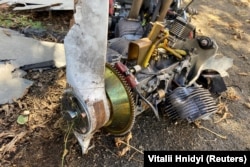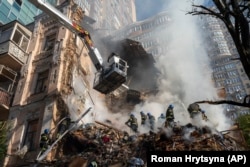Experts say Iranian-made suicide drones being used against Ukraine are a sign that Russia's stock of domestic weaponry may be severely depleted.
Dramatic images of "kamikaze drones" slamming into central Kyiv on October 17 firmly discredited Tehran's denials that it's supplying weaponry for Russia's war on Ukraine.
The pictures showed the unmistakable triangular profile of Shahed-136 drones, which Russia has rebranded with winglet markings as the Geran-2 (Geranium-2).
The drone is capable of flying hundreds of kilometers powered by a noisy, moped-like engine before detonating against a target with relative precision.
Use of the drones in Ukraine was first confirmed in August, but this week's barrage, in which several civilians were killed in view of the world's media, shot the drones into the public consciousness.
Michael J. Boyle, an associate professor at Rutgers University and the author of a book on drone warfare, told RFE/RL the recent emergence of the drones as a key weapon against Ukraine may indicate Russia's dwindling stockpiles of domestically made missiles.
Russia's "rebranding of the Shahed drones is partially to cover up the degree of its dependence on Iranian drones -- something that, given Russia's history as a defense exporter, is embarrassing," he said.
The military drone expert added that Tehran's public denials of Iranian drones being used may be a result of "Russian concerns about how this situation looks."
Videos released recently by Iran's Defense Ministry show the Shahed-136 drones being launched from a lightweight, truck-mounted frame. Each drone is blasted into the air with a disposable jet engine that is jettisoned from the drone seconds after launch as the "pusher" propeller takes over. The drones have a wingspan of 2 1/2 meters and carry an explosive warhead weighing around 40 kilograms.
The drones can be fired in groups of five in rapid succession. That "swarming" nature of a Shahed-136 strike could overcome possible reliability issues -- even if failure rates of individual drones are high, at least some are likely to reach their target. Drone swarms also serve to evade air defenses. Like a batter being pitched multiple baseballs in rapid succession, even sophisticated air-defense shields can be overwhelmed by several kamikaze drones arriving at once.
Shaheds are believed to cost just tens of thousands of dollars per unit, a small fraction of the estimated $1 million price tag for Russia's much faster and more destructive Kalibr cruise missiles.
Some media reports have suggested the drones have been significantly upgraded by Russia from the Iranian model to increase range and accuracy, but the administrator of Calibre Obscura, a popular weapons tracking website and Twitter account, told RFE/RL, "I don't see any changes so far, apart from the rebranding."
Boyle agrees, saying that, beyond the wing markings, "there is little evidence that Russia has made substantial modifications to the Iranian base model beyond the obvious step of ensuring its interoperability with its own systems."
The highly visible use of the Iranian-made weaponry on civilian centers comes as the Kremlin named General Sergei Surovikin as the head of its faltering invasion of Ukraine. Nicknamed "General Armageddon," Surovikin is known for his ruthless approach to warfare.
Boyle says the recent kamikaze drone barrages appear to mark "a shift to a punishment strategy -- in other words, just keep pounding Ukrainian military and civilian targets with repeated drone attacks to punish the population and demoralize them with power blackouts, fear, and a degrading quality of life. Even if a good number of drones are shot down," he said, "it doesn't matter because the idea is to just keep the pressure and hope to wear them down over time so they accept either submission or a deal with Russia."
Boyle believes that strategy may be self-defeating, as recent history in the former Yugoslavia and elsewhere has demonstrated.
"The problem is that punishment strategies often backfire, causing people to rally to their government rather than give in," he said.












